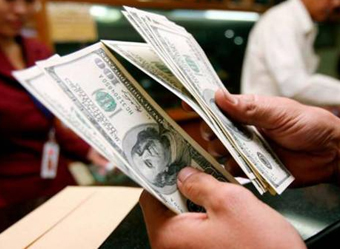The dollar inched down slightly in Asian trading on Tuesday, but maintained most of the gains it made on last week’s robust employment data that kept hope alive that the U.S. Federal Reserve could still increase interest rates this year.
The dollar index, which tracks the greenback against a basket of six major rivals, was down 0.1 percent at 93.325.
It held well above last week’s 15-month low of 92.548, though it remained shy of Friday’s post-jobs data high of 93.774 as investors pondered the timing of the U.S. central bank’s next tightening steps.
“Looking to the Fed futures market, there’s less than a 50 percent chance of one more rate hike this year,” said Bill Northey, chief investment officer at U.S. Bank Private Client Group in Helena, Montana.
Investors also await clues as to when the Fed will begin shrinking its $4.2 trillion bond portfolio.
“The September meeting is where we are anticipating the identification of the start date and we would not be surprised to see it start in an almost an immediate fashion,” he said. U.S. producer prices for July due on Thursday and consumer price index figures on Friday will give investors a clue about the extent to which the strengthening labor market is spilling over into inflation.
U.S. producer prices for July due on Thursday and consumer price index figures on Friday will give investors a clue about the extent to which the strengthening labor market is spilling over into inflation.
Last Friday’s jobs report showed nonfarm payrolls increased by a bigger-than-forecast 209,000 jobs in July, while average hourly earnings increased 0.3 percent to match expectations after rising 0.2 percent in June.
Comments on Monday from St. Louis Fed President James Bullard and Minneapolis Fed President Neel Kashkari had a muted impact on the dollar.
Bullard said the Fed can leave interest rates where they are for now because inflation is not likely to rise much even if the U.S. job market continues to improve.
The dollar edged down 0.1 percent to 110.64 yen and lost some ground against the euro, which was up 0.1 percent at $1.1809.
On Monday, the euro largely shrugged off an unexpected fall in German industrial production in June.
With the European Central Bank now widely expected to scale back its quantitative easing program as doubts rise about whether the Fed will be able to raise rates again this year, the euro is expected to hold on to its strength against the dollar.
“Overall, the numbers coming out of Europe have been quite strong,” said Bart Wakabayashi, branch manager for State Street Bank in Tokyo.
“If you look at the historical situation, back three to five years, it’s been quite a one-way trade, so it’s quite natural to have an unwind of this position, supported by overall numbers and expectations of a central bank changing their tone,” Wakabayashi said.
Against the yen, the euro was steady on the day at 130.67, down from last Wednesday’s high of 131.40 yen, its most elevated since February 2016. Japanese investors were net buyers of French bonds and sellers of German bonds in June, data from Japan’s Ministry of Finance showed on Tuesday.
The data also showed that Japanese investors sold a net 188.9 billion yen of Australian bonds in June, following 11 consecutive months of net buying. The net selling amount in June was the largest since December 2014.
The Australian dollar was steady against the Japanese yen at 87.61, below last month’s peak of 89.41, its loftiest peak since December 2015.
The Aussie added 0.1 percent to $0.7918, moving back toward its recent two-year peak of $0.8066 touched in late July.
Source: Reuters



